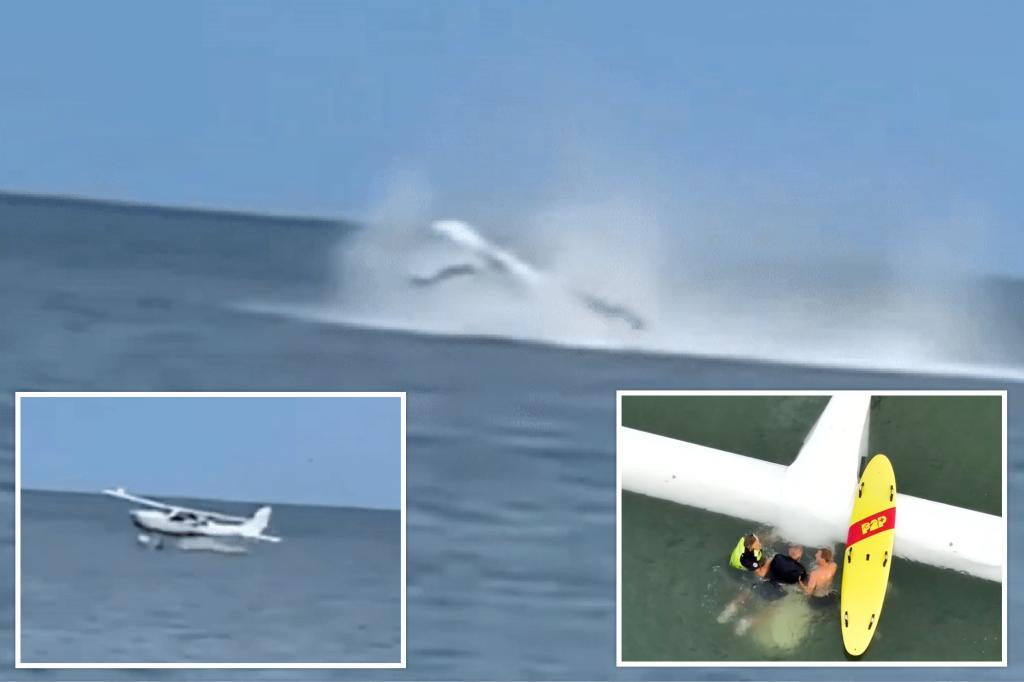Dramatic Ocean Rescue: Pilot Survives Plane Crash in the Atlantic
In a heart-stopping incident that could have ended in tragedy, pilot Mark Finkelstein survived a harrowing small aircraft crash into the Atlantic Ocean just minutes after taking off from a North Carolina airfield. The dramatic event, which occurred on August 2, 2025, at 7:33 PM, was captured on video showing the terrifying moment when Finkelstein’s single-engine plane hit the ocean at high speed near Oak Island Pier, flipping over upon impact. What followed was a remarkable rescue operation that demonstrated the extraordinary courage and quick thinking of local emergency responders who saved the pilot’s life in just 30 seconds.
According to the Oak Island Fire Department (OIFD), Finkelstein faced a pilot’s worst nightmare when his aircraft began experiencing engine failure shortly after takeoff from Cape Fear Regional Jetport. With limited options and quick decisions needed, Finkelstein made the difficult choice to attempt an emergency water landing. The crowded beach area eliminated that as a safe landing option, forcing him to guide his failing aircraft toward the open ocean. The decision, while dangerous, likely saved beachgoers from potential harm while giving Finkelstein his best chance at survival. Video footage of the crash shows the frightening moment when the plane hit the water, tumbling forward upon impact before coming to rest mostly submerged in an upright position in the Atlantic waters.
What makes this story particularly remarkable is the nature of Finkelstein’s survival inside the submerged aircraft. After the crash, the pilot found himself trapped inside the upside-down plane, surviving only by breathing from a small pocket of air that remained in the back of the aircraft’s cabin. With the cockpit largely underwater and conventional exits blocked, Finkelstein’s situation was dire and time-critical. Drone footage captured by rescuers reveals the tense moments as emergency responders reached the partially submerged aircraft and began their desperate attempt to extract the pilot from the wreckage. The rescue method proved as unconventional as it was effective – Finkelstein was guided by rescuers feet-first, underwater, and out through the windshield of the aircraft in a maneuver that saved his life.
The coordination and quick action of the rescue teams involved deserve particular recognition. The entire rescue operation took just 30 seconds from start to finish – a testament to the training, professionalism, and courage of the emergency responders from Oak Island Fire Department and other agencies involved. In those critical half-minutes, responders had to assess the situation, determine the safest extraction method, and execute a dangerous underwater rescue while ensuring both their safety and that of the pilot. The drone footage of the rescue provides a bird’s-eye view of this remarkable operation, showing how multiple rescuers worked together to pull Finkelstein to safety through the aircraft’s windshield. The speed of their response undoubtedly prevented what could have been a fatal outcome, as the aircraft could have fully submerged or sunk at any moment.
Following his rescue, a grateful Finkelstein expressed his profound appreciation to those who saved his life. “My deepest gratitude to all those who participated in rescuing and caring for me after my water landing… You were literally lifesavers!” he wrote in a statement later shared by the OIFD. The sentiment reflects the bond often formed between those rescued and their rescuers in the aftermath of such traumatic events. The pilot’s gratitude went beyond mere words – on August 11, Finkelstein visited the Southport Fire Department Caswell Station to personally meet the team responsible for pulling him from the wreckage. During this emotional reunion, he presented his rescuers with an award recognizing their exceptional service and quick work that saved his life, creating a meaningful moment of closure for everyone involved in the dramatic incident.
This remarkable survival story highlights several important aspects of aviation safety and emergency response. It demonstrates how pilot training for emergency situations can make the difference between life and death, as Finkelstein’s decision-making in those critical moments after engine failure positioned him for potential rescue rather than certain tragedy. It also underscores the vital importance of well-trained emergency responders in coastal communities where air traffic and water-related emergencies overlap. The successful rescue operation serves as a powerful reminder of human resilience in the face of disaster and the extraordinary difference that trained professionals can make when every second counts. As dramatic as the video of the crash appears, the true story is one of survival against the odds and the heroism of those who risked their own safety to save a stranger from the Atlantic’s depths after a catastrophic plane crash.











